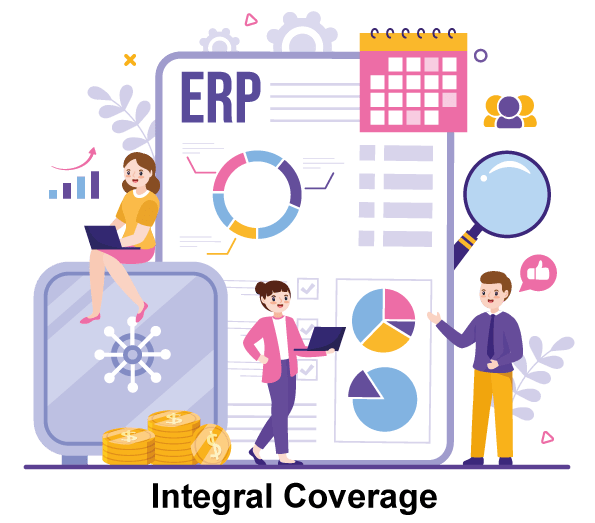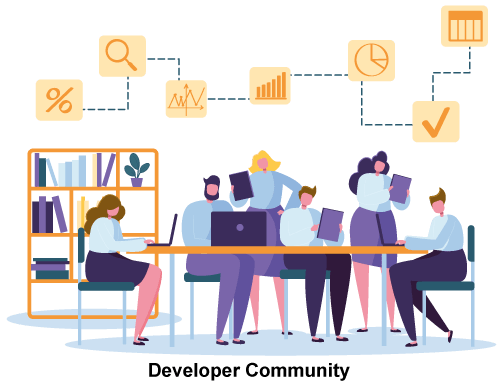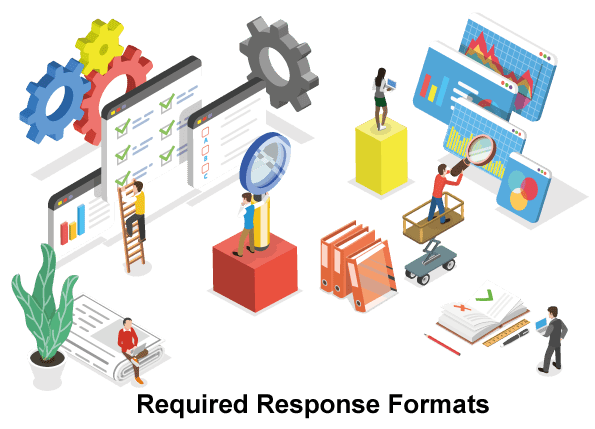Workday API Tutorial
Whether you are passionate about Workday, looking to integrate APIs more smoothly into your workflows, or something completely different – whatever brings you here today.
This blog serves to provide an in-depth manual for using Workday API effectively within operational procedures and provide instructions to incorporate it effectively.
About Workday API
Workday API Workday provides companies access to cloud-based corporate applications, financial management and human resource services in one integrated package.
Through Workday API (Application Programming Interface), developers may easily design custom apps and automate specific tasks by accessing and leveraging its features.
 These are among the main features of Workday API’s design:
These are among the main features of Workday API’s design:
Modern Architecture: Industry standards and best practices were adhered to when creating this contemporary architecture-based API, which utilises RESTful principles by employing HTTP methods on resources located through URLs to perform actions.
Wide Range of Capabilities: The Workday API offers numerous endpoints that enable users to access various Workday platform features, including payroll processing, time monitoring, financial reporting, staff management and procurement.
providing developers with ample opportunity to automate or integrate many different business processes seamlessly thanks to this comprehensive support.
Authentication and Security: Workday places a high emphasis on protecting its data processing services andits platform.
The API uses sophisticated authentication techniques that only authorised parties may access or conduct operations (for instance, tokens like OAuth 2.0 are typically employed here), helping preserve security and integrity throughout its ecosystem.
Deep Documentation:Workday provides API documentation that addresses every facet of integration, including request/response formats, endpoints, architecture features, and use case examples that help developers make optimal use of its features.
For developers, this Workday Help Documentation is indispensable in understanding how best to utilise Workday’s features.
Community and Support: Developers who utilise Workday API may become part of an active developer community that offers invaluable support, knowledge sharing and assistance when dealing with integration-related problems.
Furthermore, Workday provides dedicated channels dedicated to aiding in this process of API integration.
Benefits of Workday API
 Workday API offers several advantages that include an automated interface: Working Day API allows companies to integrate other systems.
Workday API offers several advantages that include an automated interface: Working Day API allows companies to integrate other systems.
Automating interfaces: this enables your employees to become more productive, eliminating manual data entry processes and saving on costs associated with employee time management.
Real-Time Data: Workday APIs provide real-time access to its system data for real-time decision-making purposes, providing peace of mind knowing your decisions are always informed by accurate and up-to-date data.
Secure Data Transport: Workday APIs transport data using safe methods that protect and shield any personal information stored there, giving you confidence when exchanging information as the latest security protocols defend it.
Effective Integration: Workday APIs offer an easy way to integrate with other applications like payroll, HR and finance systems – helping reduce data entry time while streamlining company operations.
Increased accuracy: Workday APIs may assist in minimising mistakes and increasing correctness by automating data entry and connecting with other systems – meaning you can rely on its accuracy and dependability when dealing with your information.
Scalability: Workday APIs allow your system to adapt as your business expands or transforms, relieving you of worries that its software won’t keep pace.
Reducing Manual Labor: Workday APIs can assist your team by automating activities and procedures that require manual labour. As a result, workers’ productivity and job satisfaction will soar due to more strategic work being completed by your workers.

Workday API Training

Features of Workday API
Workday API offers several essential features: User-Friendly Interface Workday APIs provide an accessible user experience across devices to maximise usability and make integration of other apps simpler.
 Integral Coverage Workday APIs offer an expansive set of features designed to address every facet of an enterprise’s activities – this makes for a comprehensive solution with features for payroll, finance, procurement and human resources that provide organisations with everything needed.
Integral Coverage Workday APIs offer an expansive set of features designed to address every facet of an enterprise’s activities – this makes for a comprehensive solution with features for payroll, finance, procurement and human resources that provide organisations with everything needed.
Real-time data stored within Workday systems may be accessed instantly using its APIs for instantaneous decision-making by other apps that access this real-time information instantly.
This ensures data accuracy while making swift decision-making possible by immediately providing other apps access to the updated information in real-time.
Security Workday places great emphasis on data protection. It protects private information with advanced security features that guarantee safe transfer and storage, including encryption, access restrictions, and compliance with industry standards.
Workday APIs offer businesses the scalability they need to adapt quickly to changes in data volume or user requests without disrupting efficiency or operations.
They make scaling applications up or down easily with business changes without incurring extra expenses or disrupting efficiency.
Organisations may expand and customise the features of their Workday platform to meet their specific requirements thanks to Workday APIs’ remarkable level of freedom, with developers quickly being able to integrate proprietary software or outside solutions through these APIs.
Automated Processes with Workday APIs, many jobs and procedures may be automated to reduce manual involvement while optimising operations and increasing productivity for organisations by connecting Workday with other systems via APIs.
 Developer Community and Portal Developers may access extensive documentation, tutorials, and resources on Workday’s dedicated portal to foster an engaged developer community interested in Workday integration and facilitate API integration processes.
Developer Community and Portal Developers may access extensive documentation, tutorials, and resources on Workday’s dedicated portal to foster an engaged developer community interested in Workday integration and facilitate API integration processes.
This enables a vibrant development ecosystem to take full advantage of API capabilities provided by Workday and supports API integration efforts.
Workday APIs offer enterprises seeking to automate various business operations or integrate the Workday platform with other systems an excellent option that’s safe, robust, and flexible – what enterprises require in terms of automation solutions.
Essentially, these APIs represent one-stop shops that make working together more accessible and safer than before.
Workday API rest
The Workday API provides developers with programming interfaces to interact with Workday apps and data.
You can leverage it to automate operations, interface with other systems and modify Workday features according to business needs.
Workday API is a Representational State Transfer-based API, which conforms to this architectural style commonly found in cloud-based apps such as Workday.
Below are a few key characteristics and ideas related to Workday’s API and REST implementation:
 Endpoint Identification: Before diving in with Workday API usage, one of its prerequisite steps involves learning about endpoints. Endpoints serve as URLs used to access various Workday services and resources.
Endpoint Identification: Before diving in with Workday API usage, one of its prerequisite steps involves learning about endpoints. Endpoints serve as URLs used to access various Workday services and resources.
Resource hierarchy and desired actions often dictate the structure of these endpoints, along with authentication and authorisation processes that must take place for you to access the Workday API successfully.
Authentication: verifies your identity, while authorisation defines which activities you can conduct once your identity has been confirmed.
Workday may employ authentication protocols like OAuth 2.0 to validate users and assign multiple roles or tokens for authorisation.
Request and Response Formats: Workday generally supports JSON as the primary form for making requests and receiving answers in Workday.
JSON (Java Serialization Notation) is an efficient data interchange format in programming languages that facilitates easy data transfers between activities.
Therefore, understanding its internal structures is vitalto organise JSON payloads for various activities properly.
Resource Management: The Workday API should expose various resources, including people, jobs and departments.
You should be able to use its interfaces for retrieving, creating, updating and removing these assets as necessary.
Error Handling: Error handling is an integral component of API connections; Workday will usually provide error answers that outline precisely where things went wrong and details what caused any issues with their connection.
Understanding and adequately handling errors within code are integral parts of developing robust applications.
Rate Limiting: To prevent misuse, most APIs (Workday included) impose rate restrictions that limit how often queries may be executed during any interval.
It is, therefore, imperative that developers remain mindful of such constraints and use throttle or caching solutions within their apps to adhere to them.

Workday API Online Training

Workday Developer API
The Workday Developer API gives developers access to apps developed using Workday software and data. It includes programmatic interfaces for connecting various products from Workday, such as Financial Management, Human Capital Management and Payroll.
 Here are the main components and functionalities of Workday Developer API RESTful design Workday Developer API is built around RESTful principles, using HTTP methods for resource interactions.
Here are the main components and functionalities of Workday Developer API RESTful design Workday Developer API is built around RESTful principles, using HTTP methods for resource interactions.
This offers users a consistent way of engaging with Workday data.
JSON Format the API delivers data in JSON format.
This easily parseable data interchange standard enables developers to obtain structured information from Workday and connect it with other systems or apps.
Authentication and Security the postman Workday API employs sophisticated security mechanisms to protect data access.
OAuth 2.0 authentication guarantees only authorised users or apps can gain entry to Workday data; data encryption also supports secrecy by keeping personal information private during transmission.
Workday Developer API Provides Accessible APIs The Workday Developer API offers access to numerous APIs designed to target various Workday apps.
Workday Human Capital Management API and Financial Management API each allow for interfaces with personnel management functions, while both provide interfaces for interrogating financial data and procedures.
Extensibility and Customization the API provides developers with an effective means of customising Workday functionality to fit individual business needs.
By tapping this API, they may create user interfaces, automate processes, optimise workflows and ultimately enhance usability in Workday apps.
Collaboration and Community Workday provides developers with a collaborative environment, including extensive documentation, tutorials, and an active developer community forum for assistance when using APIs efficiently or troubleshooting any potential issues.
Consequently, developers can better use Workday APIs more quickly while quickly solving any potential problems or glitches.
 Regular Updates and Patching Workday’s API is regularly upgraded with updates designed to add new features or address concerns about reliability or security, keeping up-to-date with technological advances and Workday product offerings.
Regular Updates and Patching Workday’s API is regularly upgraded with updates designed to add new features or address concerns about reliability or security, keeping up-to-date with technological advances and Workday product offerings.
With regular upgrades like these in place, upgrades ensure the API remains reliable and secure while always representing Workday product offerings at their full potential.
Remind yourself that utilising the Workday Developer API typically requires having a Workday account with suitable access credentials and following established rules and best practices for the integration of API.
Workday API Documentation
APIs like Workday provide real-time or specific data. I can give a basic idea of what you should expect when dealing with Workday API documentation and provide some essential considerations.
APIs (Application Programming Interfaces) serve as gateways between distinct software programs, enabling them to interact and collaborate seamlessly with one another.
Workday API is one such bridge; its developers will incorporate Workday features and extensions in their apps or create customised user experiences with Workday.
Authentication and Security explore the authentication methods required for accessing an workday API endpoint to protect data and prevent unwanted access.
Be sure to understand how to authenticate requests properly for maximum protection of sensitive information and protection of privacy.
Endpoints and Requests you must research all available endpoints or API methods that outline exactly which actions may be performed by each endpoint, in addition to understanding its requirements for request forms, parameters and payload data payload.

Response Formats and Status Codes Determine the required response formats (for instance, JSON or XML),andfamiliarise yourself with standard status codes that might be returned upon API requests to interpret API request outcomes correctly.
Responder code understanding provides invaluable assistance.
Request Headers and Payload Take note of any necessary or optional headers used when making API requests, learn their purpose, and how they should be utilised.
Evaluate the request payload structure and any anticipated data types to create successful interactions between API users.
Rate Restrictions and Throttling Understand the rate restrictions placed upon workday API list usage to help protect yourself against downtime or performance issues by adhering to any allowed request limits in your Workday API documentation.
Understanding throttling limitations may also assist with this effort, helping ensure no one exceeds them by exceeding them too often.
Error Handling and Exceptions When dealing with errors and exceptions in code, consult the documentation of an Workday API to gain more insight.
Recognising any of its output may result in various exceptions being returned can help ensure they’re managed appropriately within your codebase.
Versioning and Updates to stay compliant with API version changes, be aware of its versioning system.
This enables you to keep tabs on upgrades or modifications made in later releases that could potentially alter how your implementation operates.
About Workday Rest API Documentation
Workday is an intuitive cloud-based program that equips companies with financial and HR management capabilities.
Organisations use Workday extensively for payroll, benefits administration and personnel tasks.
With process automation and integration at an increasing demand, Workday has developed numerous APIs which allow developers and companies to further customize and extend the Workday experience.
Workday Rest API Documentation provides developers with comprehensive instructions to assist in creating, testing, and deploying APIs within their companies.
By connecting Workday to external systems through these Workday API get workers, businesses can increase productivity while streamlining operations; while its resources, guidelines, and technical requirements for creating or using them. This documentation serves as a great reference point.
Workday Rest API Documentation is organized into various sections, each focused on one feature or solution for payroll, human resources, administrative services or talent management.
A variety of APIs is offered within each category so companies can easily integrate Workday with existing apps and systems for creating seamless and effective workflow.
As part of its effort to aid developers in understanding and implementing each API, Workday Rest API Documentation also features code samples, request examples and response data samples for easier understanding and implementation of each API.
Workday API integration
 A Workday API, or Application Programming Interface, allows third-party apps to interact with and gain access to the Workday platform of a corporation.
A Workday API, or Application Programming Interface, allows third-party apps to interact with and gain access to the Workday platform of a corporation.
Integration: The Workday API offers seamless data connectivity to other systems like ERP, CRM or HR platforms, allowing a smooth data flow without manual entry and reducing errors caused by human input – for instance.
Custom Reports and Analytics: Utilizing Workday API to access its data can allow firms to produce custom reports and analyses as part of an expanded understanding of their workforce, making data-driven decisionsmore accessible than before.
You could even utilise it to retrieve essential fields directly from Workday and connect them to an advanced analytics platform for advanced reporting purposes.
Employee Self-Service: Using Workday API, you may design employee self-service portals and applications tailored specifically for them.
Employees could then use an external interface to access and update their information, such as benefits enrollments, time off requests or payroll records via an external interface; using API, this data would be displayed on their self-service site.
Workflow Automation: The Workday API can automate many business processes and workflows. For instance, it could automate purchase orders or invoices depending on various parameters.
Integration With Collaboration Platforms: Workday data can easily integrate with collaboration platforms like Microsoft Teams or Slack through its API, providing teams with straightforward communication and information exchange.
When an employee is hired or fired in Workday, for instance, an alert may immediately appear in an appropriate Slack channel as soon as this has happened.
Single Sign-On (SSO): With our API’s Single Sign-On features, users can log into different apps using just a single set of credentials – making the user experience better while eliminating multiple logins! This simplifies the user journey.
Always ensure any integration or automation that utilises the Workday API complies with Workday’s security and privacy requirements to protect sensitive information that must remain secured and accessible safely.
Workday RaaS (Reports-as-a-Service)
Workday RaaS platform provides an end-to-end solution that resides in the cloud to manage corporate applications, systems, and processes.
Workday RaaS integration Cloud Platform and various apps combine to deliver multi-tenant web-scale operational and data management solutions tailored to businesses of different sizes.
This platform was designed to integrate seamlessly with apps, systems, and processes already in place while giving businesses ample room to adapt as their needs shift over time.
Workday Raas API provides customers access to market interfaces, regulatory and compliance needs, centralized data transfer capabilities, and governance features.
Businesses using Workday Raas enjoy its streamlined deployment process, lower total costs, and simplified operations – three great reasons to choose it as part of your solution strategy!
Workday API Authentication
To authenticate with the Workday API, the usual steps involve: Before accessing it, obtain the necessary credentials; these typically consist of an OAuth client ID/secret combo along with a signed certificate provided by Workday when your company registers for API access.
Workday supports several authentication methods – OAuth 2.0, OAuth 2.0 with Certificate Exchange and Client Certificate Authentication – that you may choose for use within your application and infrastructure. Choose which option best meets these needs!
 Create an access token before authenticating queries against the Workday API; to do so, an OAuth 2.0 authorisation code flow should be utilised; however, alternative techniques, such as client certificate authentication, are available as alternatives.
Create an access token before authenticating queries against the Workday API; to do so, an OAuth 2.0 authorisation code flow should be utilised; however, alternative techniques, such as client certificate authentication, are available as alternatives.
With these settings – OAuth client ID and redirect URI settings included – your app transfers users directly to the Workday authentication endpoint for authentication before turning back with an authorisation code that redirects back to where your app originated from.
Your application requests Workday’s token endpoint with its OAuth client credentials and authorisation code to exchange it for an access token.
To authorise and authenticate access, the token endpoint issues a token. Subsequent API calls require you to include this token in their Authorization header for security reasons.
You are making API Calls using Your Access Token. When sending Workday API python example requests to Workday’s APIs using OAuth 2.0 authentication methods (such as Bearer Token for OAuth 2.0), include your access token in the Authorization header of the request message.
Handle authentication issues with grace. Your application should address authentication-related difficulties gracefully, such as expired tokens or incorrect credentials causing problems when authentication attempts occur.

Workday API Course Price


Sindhuja
Author